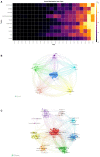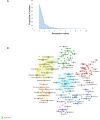A bibliometric and visual analysis of cancer-associated fibroblasts
- PMID: 38173726
- PMCID: PMC10762783
- DOI: 10.3389/fimmu.2023.1323115
A bibliometric and visual analysis of cancer-associated fibroblasts
Abstract
Background: Cancer-associated fibroblasts (CAFs) represent the predominant stromal component within the tumour microenvironment (TME), exhibiting considerable heterogeneity and plasticity that significantly impact immune response and metabolic reprogramming within the TME, thereby influencing tumour progression. Consequently, investigating CAFs is of utmost importance. The objective of this study is to employ bibliometric analysis in order to evaluate the current state of research on CAFs and predict future areas of research and emerging trends.
Methods: Conduct a comprehensive search for scholarly publications within the Web of Science Core Collection database, encompassing the time period from January 1, 2001, to December 31, 2022. Apply VOSviewer, CiteSpace, R software and Microsoft Excel for bibliometric analysis and visualisation.
Results: This study involved a comprehensive analysis of 5,925 publications authored by 33,628 individuals affiliated with 4,978 institutions across 79 countries/regions. These publications were published in 908 journals, covering 14,495 keywords and 203,947 references. Notably, there was a significant increase in articles published between 2019 and 2022. China had the highest count of articles, while the United States emerged as the most frequently cited country. The primary research institutions in this field were Shanghai Jiao Tong University, Harvard University, and the University of Texas MD Anderson Cancer Center. Sotgia, Federica and Lisanti, Michael P from the University of Manchester, and Martinet, Wim from the University of Antwerp were the most prolific and highly cited authors. The journal Cancers had the highest number of publications, while Cancer Research was the most frequently cited journal. Molecular, biology, immunology, medicine and genetics were the main research disciplines in the field of CAFs. Key directions in CAFs research encompassed the study of transforming growth factor-β, Fibroblast Activation Protein, breast cancer, as well as growth and metastasis. The findings from the analysis of keyword co-occurrence and literature co-citation have revealed several emerging hotspots and trends within the field of CAFs. These include STAT3, multidrug resistance, pancreatic ductal adenocarcinoma, pan-cancer analysis, preclinical evaluation, ionizing radiation, and gold nanoparticles.
Conclusion: Targeting CAFs is anticipated to be a novel and effective strategy for cancer treatment. This study provides a comprehensive overview of the existing research on CAFs from 2001 to 2022, utilizing bibliometric analysis. The study identified the prominent areas of investigation and anticipated future research directions, with the aim of providing valuable insights and recommendations for future studies in the field of CAFs.
Keywords: bibliometrics; cancer; cancer-associated fibroblasts; hot spots; research trends.
Copyright © 2023 Yuan, Zhang, Chen, Yuan, Zhuang, Zhou, Li, Qiu and Zhou.
Conflict of interest statement
The authors declare that the research was conducted in the absence of any commercial or financial relationships that could be construed as a potential conflict of interest.
Figures








References
Publication types
MeSH terms
Substances
LinkOut - more resources
Full Text Sources
Medical
Miscellaneous

